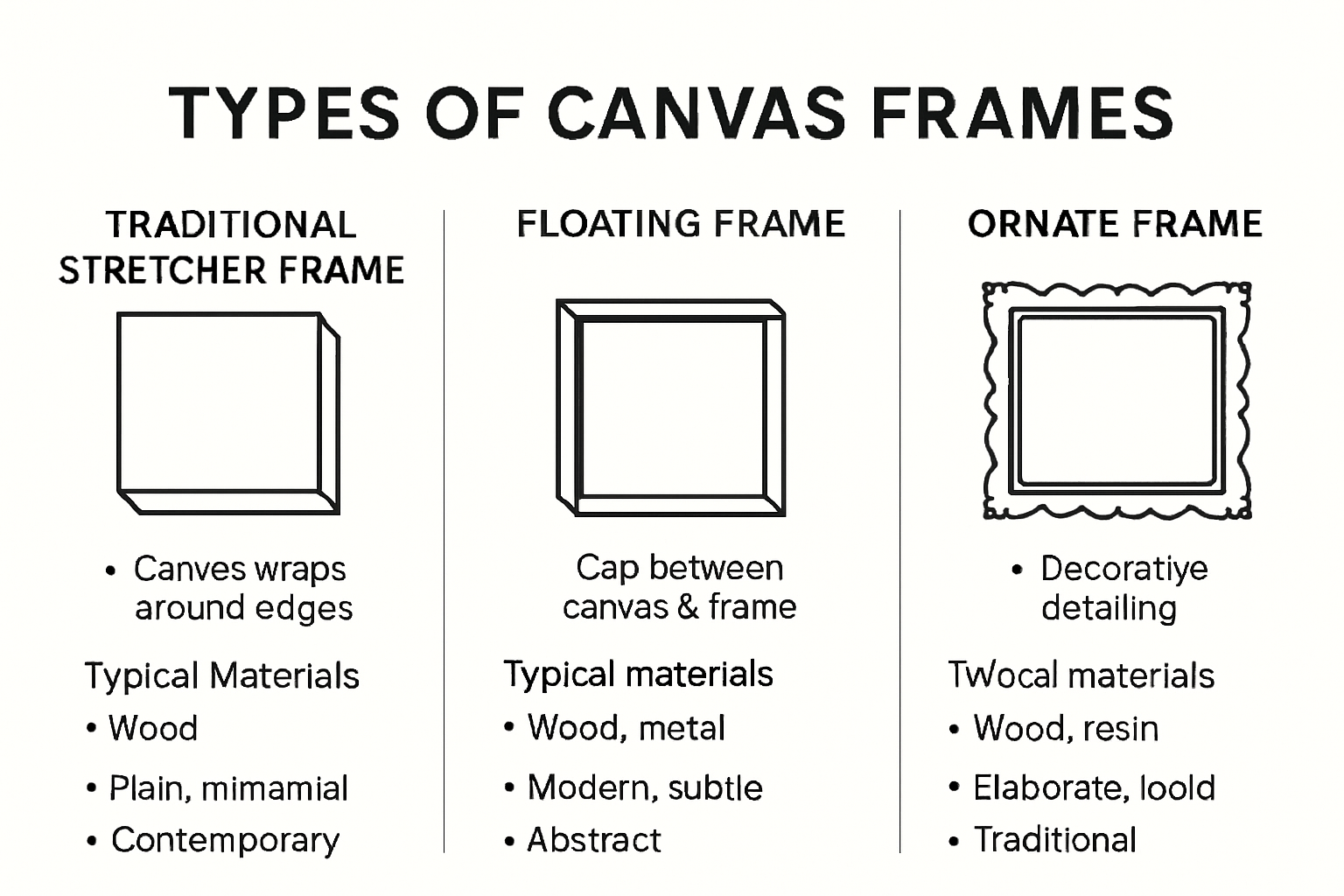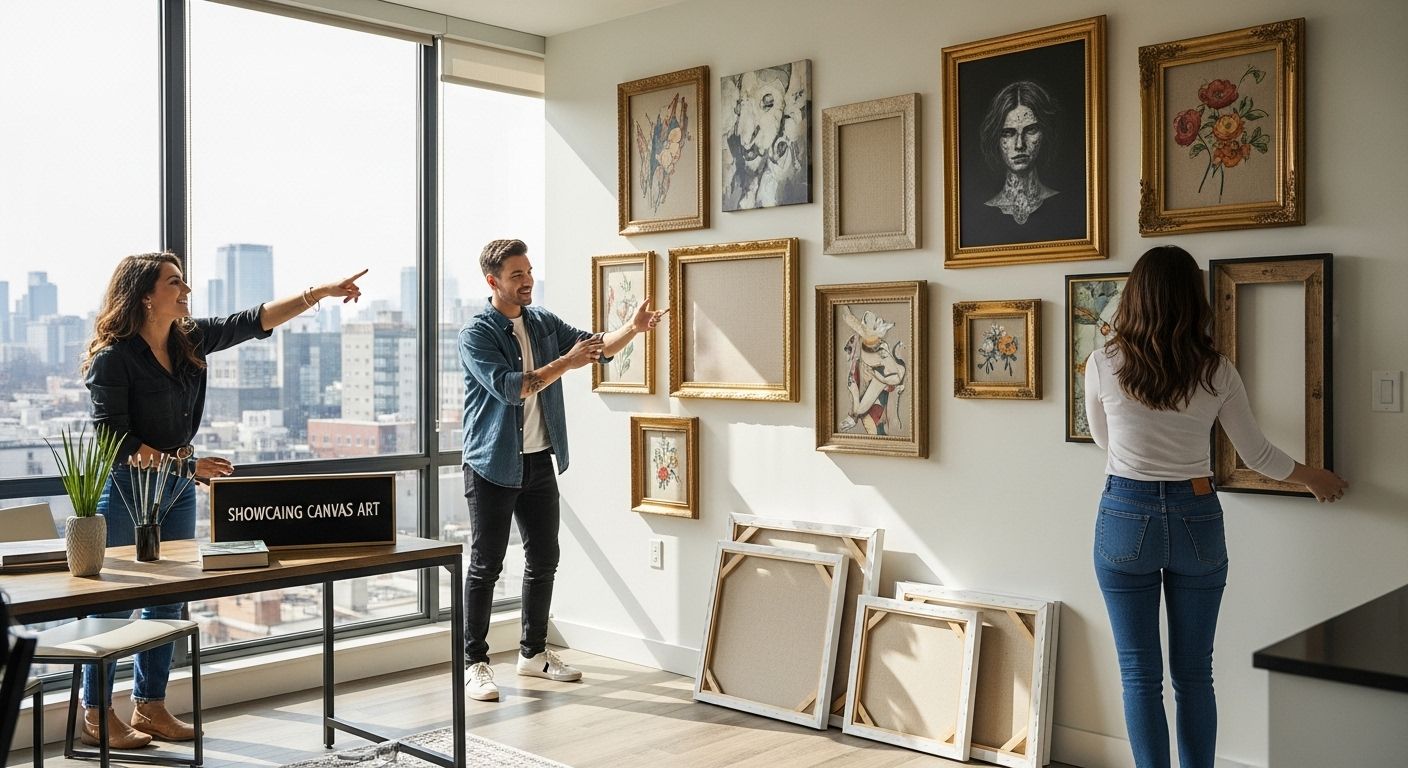
Creative Ways to Frame Canvas Art for Stunning Displays

Framing canvas art turns a plain painting into a center stage masterpiece for any room. Strange as it sounds, picking the frame can actually change how much people value the art—museum studies show the right frame can boost the perceived importance of a piece by over 35 percent. Forget about basic borders for a moment. Even reclaimed pallets or floating designs can create displays that look custom and dramatic, with surprisingly little effort.
Table of Contents
- Types Of Frames For Canvas Art
- DIY And Budget-Friendly Canvas Framing
- Choosing Frames For Modern Or Luxury Appeal
- Tips For Showcasing And Hanging Canvas Art
Quick Summary
| Takeaway | Explanation |
|---|---|
| Use traditional stretcher frames for simplicity | Stretcher frames maintain canvas tension and are ideal for a clean, minimalist presentation of artwork. |
| Consider floating frames for contemporary style | Floating frames create a modern look, allowing the canvas to appear as if it hovers within the frame, enhancing visual depth. |
| Explore DIY options for budget-friendly framing | Repurposing materials like pallets or using wooden battens allows for creative and affordable framing solutions without sacrificing aesthetics. |
| Hang artwork at eye level for best impact | Position artwork 57-60 inches from the floor to achieve optimal visibility and aesthetic balance in any space. |
| Utilize proper mounting techniques for security | Employ hardware appropriate for your wall type and secure canvases with sturdy wires to prevent damage and ensure straight alignment. |
Types of Frames for Canvas Art
Framing canvas art transforms a simple piece into a stunning visual statement that can elevate any interior space. Understanding the various frame types allows art enthusiasts to showcase their favorite pieces with precision and style.

Traditional Stretcher Frames
Stretcher frames represent the most fundamental way of presenting canvas art. Learn more about canvas art display techniques These rectangular wooden frames form the essential foundation for mounting canvas pieces. According to research from art preservation experts, stretcher frames provide a clean, minimalist approach that allows the artwork itself to remain the primary focus. Typically constructed from lightweight wood like pine or cedar, these frames are designed to keep the canvas taut and prevent warping over time. Professional artists and galleries frequently utilize stretcher frames because they offer structural integrity while maintaining the artwork’s original presentation.
The construction of stretcher frames involves precise engineering. Each wooden bar is carefully cut and joined at perfect right angles, ensuring the canvas remains flat and secure. Some advanced stretcher frames feature adjustable tension mechanisms that allow artists and collectors to fine-tune the canvas’s tautness, preventing potential sagging or rippling.
Floating Frame Designs
Floating frames represent a more contemporary approach to canvas art presentation. As experts in art framing explain, these innovative frames create a dramatic visual effect where the canvas appears to hover within the frame’s boundaries. The unique mounting technique involves attaching the canvas from behind, which creates a small gap between the artwork and the frame’s edges. This design technique produces a sense of depth and dimensionality that traditional framing methods cannot achieve.
Floating frames are particularly popular among modern art collectors and interior designers seeking to create a sleek, gallery-like aesthetic. They work exceptionally well with minimalist and contemporary art pieces, drawing attention to the artwork’s edges and providing a sophisticated presentation. Materials like brushed metal, slim wood, and acrylic are commonly used to construct floating frames, offering various stylistic options to complement different interior design schemes.
Decorative and Ornate Frames
For those seeking a more dramatic and classical presentation, ornate frames provide a stunning alternative. Art historians suggest that highly decorative frames can dramatically transform an artwork’s visual impact. These frames often feature intricate carvings, gilded surfaces, and elaborate designs that harken back to traditional European art presentation styles. Ornate frames work particularly well with classical portraits, historical scenes, and symbolic artworks that benefit from a sense of historical gravitas.
The selection of an ornate frame requires careful consideration of the artwork’s style, color palette, and intended display environment. A well-chosen decorative frame can elevate a simple canvas piece into a statement of artistic sophistication, creating a focal point that captures viewers’ attention and sparks conversation. Whether featuring baroque-inspired gold leaf designs or intricately carved wooden motifs, these frames offer a timeless approach to canvas art presentation that transcends contemporary design trends.
To help you compare popular canvas framing techniques, the following table summarizes the key features, styles, and ideal uses for each major frame type discussed above.
| Frame Type | Key Features | Best For |
|---|---|---|
| Traditional Stretcher Frames | Lightweight wood, keeps canvas taut, minimalist look | Clean, classic presentation |
| Floating Frames | Creates gap around canvas, adds depth, modern aesthetic | Contemporary & modern art |
| Decorative/Ornate Frames | Intricate carvings, gilded surfaces, classic European style | Classical, portrait, & statement art |
DIY and Budget-Friendly Canvas Framing
Creating beautiful canvas art displays doesn’t have to break the bank. With some creativity and basic crafting skills, art enthusiasts can transform their canvas pieces into stunning wall decor without spending a fortune. Explore affordable art display solutions that make professional-looking framing accessible to everyone.
Repurposing Everyday Materials
Home DIY framers have numerous innovative options for creating custom canvas frames using readily available materials. According to creative design experts, wooden pallets, reclaimed lumber, and even old picture frames can be transformed into unique canvas frame designs. Wooden pallets, often available for free from local businesses, can be carefully dismantled and reconstructed into rustic frame structures that add character and charm to canvas artwork.
The process of repurposing materials involves careful selection and preparation. Look for wooden pieces without significant damage or rot. Sanding can help smooth rough edges and create a polished finish. For those seeking a more refined look, consider staining or painting the reclaimed wood to match your interior design aesthetic. This approach not only saves money but also provides a sustainable solution for art display.
No-Frame Mounting Techniques
Alternative mounting techniques offer budget-conscious art lovers creative ways to display canvas without traditional framing. Interior design specialists recommend several innovative approaches that eliminate the need for expensive frames. Mounting canvas using simple wooden battens or creating a gallery-style wall hanging can provide a modern, minimalist presentation.
Wooden battens can be easily attached to the top and bottom of a canvas, creating a clean, streamlined look. These can be painted to match wall colors or left in their natural wood tone for a rustic effect. Another budget-friendly technique involves using industrial-style metal clips or magnetic hanging systems, which offer a contemporary approach to canvas display. These methods work particularly well for smaller canvases and create an art gallery-inspired aesthetic without significant investment.
Affordable Framing Materials and Techniques
For those wanting a more traditional framed look, numerous affordable framing options exist. Craft stores and home improvement centers offer relatively inexpensive wooden molding that can be cut and assembled into custom frames. Basic woodworking skills and a few essential tools like a miter saw, wood glue, and sandpaper can help create professional-looking frames at a fraction of the cost of professional framing services.
Consider exploring different finishing techniques to elevate budget-friendly frames. Spray paint can quickly transform plain wooden molding into metallic or matte frames that complement various interior design styles. Wood stains offer another cost-effective way to create custom finishes that match existing furniture or room decor. Some DIY enthusiasts even use unconventional materials like PVC pipes or cardboard as frame bases, demonstrating that creativity and imagination can overcome budget constraints.
The key to successful DIY canvas framing is patience and willingness to experiment. While professional framing services offer convenience, the personal satisfaction of creating a custom frame that perfectly showcases your artwork is unparalleled. Each DIY frame becomes a unique artistic statement, reflecting personal creativity and resourcefulness.
For readers interested in budget-friendly and DIY canvas framing, this table outlines affordable approaches, materials needed, and their main advantages based on the article’s guidance.
| DIY Framing Approach | Materials Used | Main Benefit |
|---|---|---|
| Repurposing Everyday Materials | Wooden pallets, old frames | Cost-effective, sustainable, unique look |
| No-Frame Mounting Techniques | Wooden battens, metal clips, magnets | Minimalist, modern style, easy to update |
| Affordable Framing Materials | Inexpensive molding, PVC, cardboard | Traditional look on a budget, customizable |
Choosing Frames for Modern or Luxury Appeal
Framing serves as more than just a protective border for canvas art it is a critical design element that can dramatically transform the artwork’s visual impact and perceived value. Discover contemporary art display techniques that elevate your canvas pieces from simple decorations to sophisticated statement pieces.
Minimalist Metal Frames
Modern design enthusiasts gravitate towards sleek, minimalist metal frames that offer a clean and sophisticated presentation. According to design experts, metal frames provide a contemporary aesthetic that complements abstract and geometric artworks. Aluminum and stainless steel frames create a seamless, almost invisible boundary that allows the artwork to take center stage. These frames work exceptionally well in spaces with industrial or minimalist design schemes, offering a refined and understated elegance.
The key to selecting the perfect metal frame lies in understanding its subtle interaction with the artwork. Thin profile frames in brushed silver or matte black can create visual depth without overwhelming the canvas. Some contemporary metal frames feature innovative design elements like floating edges or embedded LED lighting, transforming the framing process from a mere functional requirement to an artistic statement in itself.
Luxury Wood and Premium Materials
For those seeking a more opulent approach, luxury wood frames represent the pinnacle of canvas art presentation. Conservation specialists highlight the importance of selecting high-quality materials that complement the artwork’s structural integrity. Premium woods like walnut, mahogany, and rare exotic hardwoods offer rich textures and depth that elevate canvas art from decorative to collectible.
Luxury framing goes beyond simple material selection. Handcrafted frames with intricate details, such as carefully mitered corners, hand-rubbed finishes, and custom staining techniques, transform the frame into a work of art in its own right. Some high-end frames incorporate unexpected materials like carbon fiber, brushed titanium accents, or hand-applied gold leaf, creating a truly unique presentation that reflects sophisticated design sensibilities.
Contemporary Conceptual Framing
Contemporary art demands innovative framing approaches that challenge traditional boundaries. Research on design requirements suggests that more formal and creative framing can significantly impact how viewers perceive artwork. Conceptual framing techniques include transparent acrylic frames that create a floating effect, asymmetrical designs that break traditional rectangular constraints, and frames that incorporate mixed materials like wood and metal.
These avant-garde framing methods are particularly effective for modern art pieces that push traditional aesthetic boundaries. Some contemporary frames intentionally contrast with the artwork, creating visual tension and encouraging viewers to engage more deeply with the piece. Frameless mounting techniques, where the canvas appears to float slightly away from the wall, offer another sophisticated approach that appeals to minimalist design enthusiasts.
Selecting the right frame is an art form in itself. Whether you prefer the understated elegance of metal frames, the rich warmth of luxury wood, or the bold statement of conceptual design, the perfect frame can transform a simple canvas into a museum-worthy masterpiece. Consider your artwork’s style, your interior design scheme, and your personal aesthetic when making this crucial design decision.
Tips for Showcasing and Hanging Canvas Art
Showcasing canvas art is an art form that extends beyond selecting the perfect piece. Strategic placement, proper hanging techniques, and thoughtful presentation can transform an ordinary wall into a captivating visual experience. Explore expert art display strategies to elevate your interior design and highlight your artwork’s unique beauty.
Optimal Placement and Positioning
The placement of canvas art dramatically influences its visual impact and the overall ambiance of a space. According to museum display experts, artwork should ideally be hung at eye level, which typically means the center of the canvas should be approximately 57-60 inches from the floor. This height creates a natural viewing perspective that works in most residential and professional settings.
When positioning multiple canvas pieces, consider creating visual balance and harmony. Gallery walls offer an exciting alternative to traditional single-piece displays. Experiment with different arrangements by first laying out your canvas pieces on the floor to test composition. Maintain consistent spacing between artworks, typically 2-3 inches, to create a cohesive and intentional look. For larger walls, consider creating a focal point with a statement piece and surrounding it with complementary smaller canvases.
Proper Hanging Techniques
Conservation specialists emphasize the importance of secure and appropriate hanging methods. Different wall types require specific hardware to ensure artwork remains safely mounted. For drywall, use expandable wall anchors or wall plugs that can support the weight of your canvas. Avoid hanging artwork near direct sunlight, heating vents, or areas with significant temperature fluctuations, which can cause damage to the canvas and frame.
Professional art hanging involves more than simply inserting a nail into the wall. Art center experts recommend using a sturdy wire system attached to the stretcher bars, not the frame itself. This method distributes weight more evenly and prevents potential damage. Use a spirit level to ensure your artwork hangs straight, making small pencil marks to guide precise placement. For heavier canvases, consider using multiple hanging points or specialized picture hanging systems that provide additional support.
Creating Visual Narratives and Environments
Beyond technical considerations, canvas art placement is an opportunity to create visual narratives within your living or working space. Think of your walls as a canvas, with each artwork contributing to a larger story. Consider the color palette of your room, the architectural elements, and the mood you want to create. Dramatic, large-scale pieces can serve as room focal points, while smaller canvases can be grouped to create interesting visual dialogues.
Consider the context of each room when selecting canvas placement. In living areas, choose pieces that inspire conversation and reflect your personal aesthetic. Home offices might benefit from motivational or thought-provoking artwork that stimulates creativity. Bedrooms can feature more serene, calming pieces that contribute to a restful atmosphere. Remember that lighting plays a crucial role in showcasing canvas art. Use strategic ambient or directional lighting to highlight textures, create shadows, and enhance the artwork’s depth and dimensionality.

Mastering the art of canvas display requires a blend of technical precision and creative intuition. By understanding placement principles, employing proper hanging techniques, and thoughtfully curating your space, you can transform your walls into compelling visual experiences that reflect your unique style and artistic sensibility.
Frequently Asked Questions
What types of frames are best for canvas art?
Traditional stretcher frames are ideal for a clean, minimalist look, while floating frames enhance contemporary art with a sense of depth. Ornate frames provide a classical touch for more dramatic presentations.
How can I frame canvas art on a budget?
Consider repurposing materials such as wooden pallets or using affordable framing techniques like mounting with wooden battens. These options can create stylish displays without high costs.
What is the recommended hanging height for canvas art?
Artwork should be hung at eye level, typically with the center of the canvas approximately 57-60 inches from the floor for optimal visibility and aesthetic balance.
Are there any modern framing techniques for contemporary art?
Yes, contemporary conceptual framing methods include using acrylic frames for a floating effect and designing asymmetrical frames that break traditional rectangular boundaries, which can enhance the visual impact of modern artworks.
Transform Your Canvas Art Into a Conversation Piece With Marta Ellie
If you have been inspired by new ways to frame and display canvas art, now is the perfect moment to elevate your own collection. Many readers struggle to find unique, high-quality pieces that truly shine, whether they want classic simplicity, dramatic floating frames, or personalized displays that capture special occasions. Your space deserves art that is not only beautifully crafted but ready for showstopping presentation. Looking for canvas art that becomes the centerpiece of family gatherings and unforgettable moments? Discover purpose-made selections in our Family Reunion Memory Wall Art collection and experience the difference a well-chosen frame and premium print can make.

Every canvas from Marta Ellie arrives with the same attention to detail described in our article, offering beautiful structure and material options that complement modern, traditional, and luxury framing techniques. Ready to create a standout display and turn your walls into stories? Take the next step and browse Marta Ellie’s main site for exclusive pieces that harmonize with every framing style and capture your personal vision of home.
Recommended
- Canvas vs Framed Prints: Choosing the Right Art for 2025 – Exclusive Canvas Art
- How to Display Canvas Prints: Fresh Ideas for Modern Walls 2025 – Exclusive Canvas Art
- Caring for Canvas Art: Expert Tips for Wall Decor 2025 – Exclusive Canvas Art
- Preserving Canvas Artwork: Best Tips for Art Lovers 2025 – Exclusive Canvas Art